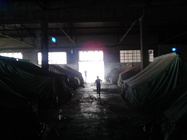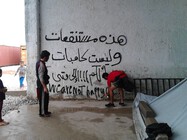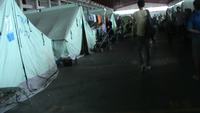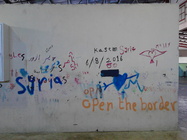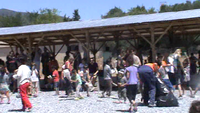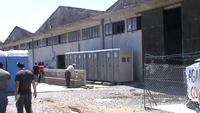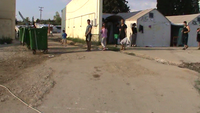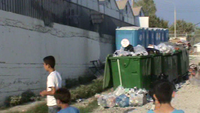"Hurriya, Azadi, Freedom now!"
An ethnomusicological report on the events of Thessaloniki, Greece 2016
Ioannis Christidis, August 20201
The socio-political context
The slogan "Hurriya, Azadi, Freedom now!" 🔊 (Sample 1) was chanted in protests, in singing and dancing 🔊 (Sample 2), in the summer of 2016, in Thessaloniki, a city in northern Greece, by people mainly coming from war-torn Syria, protesting for the re-opening of European borders and against their forced settlement in refugee camps. Throughout the previous months, between May 2015 and March 2016, the refugee movement through Turkey towards Europe was at its peak, encompassing mass border-crossings, traveling by any possible – risky – means, setting up of makeshift camping zones along the "Balkan route," from Greece to the Austrian borders. These appalling conditions led many countries, under the leadership of Germany, to loosen their border controls and let people pass. However, the EU-Turkey Refugee Deal of March 2016 put an end to this period. Greece until then had constituted a transit country. With the closure of the North Macedonian borders, about 15,000 refugees, mainly coming from Syria, Afghanistan and Iraq, were blocked near the Greek village of Idomeni. After two months of several protests and border-crossing attempts, all these people, who were settled in a huge makeshift camp near the border, were finally forcibly moved by the Greek authorities into twelve ramshackle refugee camps, in old warehouses, abandoned factories and military facilities, on the outskirts of Thessaloniki, at a distance of 70km from the border.2 Within this context, several protests took place in the center of the city and in the refugee camps themselves, encouraged by emergent social relationships of solidarity and struggle between international and local activists and the refugees.
Music, singing and dancing, some initial impressions
What was so unique about these manifestations was that music, singing and dancing was present in almost all of them. Moreover, the main protagonists of these musical performances were young men of Syrian-Arabic origin, who sang and danced, foremost, to Arabic music alongside international pop, hip-hop and other genres. At first glance, these random, spontaneous and dynamic musical expressions contrasted strongly with dominant social expectations around refugees' vulnerability and around conventional performance contexts that tend to exoticize the music of migrants and refugees. Within the context of the protests, the Arabic songs and dances caused some surprise to local activists. Although Middle Eastern tunes are not unfamiliar within modern Greek popular music,
3 the majority of activists, being accustomed to punk, rock or hip-hop "political" music, did not really participate enthusiastically in them.
4 In contrast, when during a student concert, a refugee from Syria went on stage and started rhyming a rap song in Arabic, even if the majority of the audience did not understand a word, people broke out into intense applause and whistles. Much more surprising was that despite the abject living conditions in refugee camps, any time a speaker was brought there by activists, young men from Syria then residents of the camps, would bring their mobile phones, connect them with the speaker and start playing Arabic popular dance music 🎬 (Sample 3), setting circle dance sessions before proceeding to any verbal statements. Once, this ended up in a Macarena dance performance 🎬 (Sample 4), with some children taking over the dance space.
Even though throughout these events music generally seemed to play an integral role in refugees' individual and collective empowerment, particularly those directly involved in the music-making, it is not naive to assume that there was also a serious gap in understanding between performers, audiences and attendants, stemming from the differences in social, cultural, political and gender experiences, as well as power positions, in this coming together. This mingling finally produced exceptional and simultaneously very puzzling and challenging conditions for musical experience and meaning. Besides my involvement in all these events as a politically engaged native of Thessaloniki, I was also experiencing them as a musician, a player of the middle-eastern oud and, at that time, as a student of musicology, trained in ethnographic methods deriving from ethnomusicology. This personal background attuned me to the peculiarity of these musical expressions and motivated me to start to document them.
From action to ethnomusicological research to action
At the beginning, I did not know how the recorded material could be useful, apart from being a way to "preserve" memory in a personal archive. Considering the aforementioned deficiency in understanding and presuming that by knowing each other better we could become more politically effective, there was later added a feeling of personal responsibility: to use my training and the skills I had developed so as to make accessible and understandable, to myself and to others, the message and the meaning of this music. Finally, in order to find some answers, as to what these musical performances were, what they really meant for their actors and what their socio-political implications were, I decided to convert my initial documentations into an evidence source for a PhD research project in ethnomusicology.
Ethnomusicology is a scholarly source of theories and methods by which we can come closer to the understanding of the music-making of people with diverse cultural backgrounds, specifically through ethnographic field research and its participatory and dialogic features.
6 Furthermore, applied ethnomusicology suggests that "knowing about music" can enhance socio-political possibilities for the advocacy of individuals or communities of less power within power hierarchies based on ethnicity, gender, race, class, and so on.
7 Drawing on ethnomusicological research on music and forced migration;
8 music and minorities;
9 music and politics;
10 and fieldwork theories and methods appropriate to my topic,
11 my research approach was finally developed into a comparative multi-sited research project with "action" perspectives, within which the events of Thessaloniki constitute today only the point of departure. In this on-line report, I briefly present the way I organized and worked with the field documentations from Thessaloniki I then proceed to a summarized description of their content, and at the end, I put forward some initial assumptions and underscore some noteworthy emerging issues.
The archive and its content
A substantial step I made regarding the collected audiovisual material and written testimonies was the creation of a consistently updated archive, which serves as the data source for my research. At the moment, this consists of personal audiovisual field-recordings from Thessaloniki 2016, sometimes made in collaboration with music performers and their companions; of field-notes, including descriptions of non-recorded performances; of numerous music-related videos or images uploaded on-line by activist-refugees or engaged journalists; and of interviews conducted by me with interlocutors important for the research. By retracing and examining this volume of documentation, and by consulting the existing literature, I have come to a point where I am able to present some initial findings, rather more descriptive than interpretative. These are articulated in respect of general musical background and music genres; general contexts for musical performances; documented instruments and devices for musical use; most frequent types of music for dance; song repertoires and singing performances.
General musical background and music genres
The majority of the recorded songs and dances were performed by young men of Syrian-Arab origins. Their music style could be generally categorized as Arabic: that is music (and dance-music) characterized by the use of the Arabic language in the lyrics and a combination of elements stemming from Middle-Eastern music traditions, as well as from Islamic religious heritage and various musical idioms of ethnic and tribal communities that exist throughout the Arab-speaking world.
12 Most of the documented songs could be categorized as modern popular Syrian-Arabic music, a genre that, on the one hand, shares common characteristics with international pop, such as the use of digital instrumentation, but on the other hand, maintains the modal characteristics of its Arab background and in many instances expresses local rural "traditional" or "folk" idioms. Besides this, there were also documented genres such as hip-hop, metal and international pop music, as well as religious music.
General contexts for musical performances
There were four main contexts for musical performances: (a) Music within protests in urban public spaces. Usually some protesters, residents of the refugee camps, would use a microphone connected to an amplifier and speakers in order to sing, or they would connect their mobile phones so as to play music for dancing. (b) Music in refugee camps. This mainly included dancing to recorded music played through speakers combined with protest activities, dancing activities for children, musical evenings for entertainment usually during leisure time in tents, live or recorded religious chants, performed in specially adapted tents to be used as mosques, and in one case, singing or instrumental performances in the context of a music competition entitled "Refugees got Talent." (c) Music within musical evenings or parties outside the camps, in cafés, public spaces or at gatherings in apartments. (d) Music during transportation 🎬 (Sample 5), e.g. in a bus from the refugee camp to the center of Thessaloniki.
Documented instruments and devices for musical use
The documented musical instruments included the saz 📷 (Figure 9), the oud 📷 (Figure 10), the guitar 📷 (Figure 11), the darbuka 📷 (Figure 12) and makeshift percussion 🎬 (Sample 6).
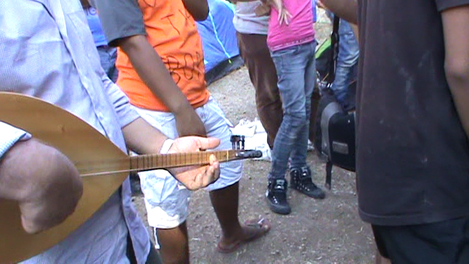 Figure 9 – A man performing the saz during a protest at the campus of Aristotle University of Thessaloniki, July 2016, photo by Ioannis Christidis.
Figure 9 – A man performing the saz during a protest at the campus of Aristotle University of Thessaloniki, July 2016, photo by Ioannis Christidis.
![Figure 10 – A man performing the oud in "Oreokastro" refugee camp, screenshot from Al-Jazeera's documentary "Refugees got Talent," by Theopi Skarlatos, March 2017. On-line: https://www.aljazeera.com/programmes/witness/2017/03/refugees-talent-170323115635234.html [03.08.2020].](https://www.mdw.ac.at/upload/MDWeb/musicandminorities/img/Figure10OudscreenshotfromAlJazeera_newcss.png) Figure 10 – A man performing the oud in "Oreokastro" refugee camp, screenshot from Al-Jazeera's documentary "Refugees got Talent," by Theopi Skarlatos, March 2017. On-line: https://www.aljazeera.com/programmes/witness/2017/03/refugees-talent-170323115635234.html [03.08.2020].
Figure 10 – A man performing the oud in "Oreokastro" refugee camp, screenshot from Al-Jazeera's documentary "Refugees got Talent," by Theopi Skarlatos, March 2017. On-line: https://www.aljazeera.com/programmes/witness/2017/03/refugees-talent-170323115635234.html [03.08.2020].
![Figure 11 – A man performing the guitar in "Oreokastro" refugee camp, screenshot from Al-Jazeera's documentary "Refugees got Talent," by Theopi Skarlatos, March 2017. On-line: https://www.aljazeera.com/programmes/witness/2017/03/refugees-talent-170323115635234.html [03.08.2020].](https://www.mdw.ac.at/upload/MDWeb/musicandminorities/img/Figure11GuitarscreenshotformAlJazeera_newcss.png) Figure 11 – A man performing the guitar in "Oreokastro" refugee camp, screenshot from Al-Jazeera's documentary "Refugees got Talent," by Theopi Skarlatos, March 2017. On-line: https://www.aljazeera.com/programmes/witness/2017/03/refugees-talent-170323115635234.html [03.08.2020].
Figure 11 – A man performing the guitar in "Oreokastro" refugee camp, screenshot from Al-Jazeera's documentary "Refugees got Talent," by Theopi Skarlatos, March 2017. On-line: https://www.aljazeera.com/programmes/witness/2017/03/refugees-talent-170323115635234.html [03.08.2020].
![Figure 12 – A man performing the darbuka in "Oreokastro" refugee camp, screenshot from Al-Jazeera's documentary "Refugees got Talent," by Theopi Skarlatos, March 2017. On-line: https://www.aljazeera.com/programmes/witness/2017/03/refugees-talent-170323115635234.html [03.08.2020].](https://www.mdw.ac.at/upload/MDWeb/musicandminorities/img/Figure12DarbukaScreenshotfromAlJazeera_newcss.png) Figure 12 – A man performing the darbuka in "Oreokastro" refugee camp, screenshot from Al-Jazeera's documentary "Refugees got Talent," by Theopi Skarlatos, March 2017. On-line: https://www.aljazeera.com/programmes/witness/2017/03/refugees-talent-170323115635234.html [03.08.2020].
Figure 12 – A man performing the darbuka in "Oreokastro" refugee camp, screenshot from Al-Jazeera's documentary "Refugees got Talent," by Theopi Skarlatos, March 2017. On-line: https://www.aljazeera.com/programmes/witness/2017/03/refugees-talent-170323115635234.html [03.08.2020].
Some individual musicians carried their instruments with them along their refugee journey. Besides that, other devices extensively used for music purposes were speakers (in the beginning provided by activists) and mobile phones. Very often these musical performances were recorded and later uploaded or live-streamed on Facebook or YouTube, specifically in pages with activist content managed by the residents of refugee camps.
Most frequent types of music for dance
Apart from a few exceptions where dance was accompanied by music labeled as international-pop played through speakers in order for children to dance, or by other genres, such as hip-hop or metal that served as party-music for dancing, the majority of documented music for dance performances was generally recognized as dabke music. Dabke ([AR]: دبكة,) is a type of popular circle or line dance, where dancers holding hands perform specific steps that vary according to the chosen style or the origins of the dance. Dabke, translated as "dance," is accompanied by dabke music, literally, "music for dance." Dabke music is associated with a special type of music, known as musiqa shaʿbiyya, which means folk/popular music (Silverstein 2012, 2016, 2018).
15 It constitutes a developing musical idiom that combines singing, lively beats and performing of digital instruments in a "traditional" way and is connected to the working and rural classes of Syria, and other areas of the Middle East, such as Lebanon, Palestine, Israel, Jordan and Iraq. Dabke is mainly performed in festivals and family celebrations within secular contexts and is not considered as merely Arabic, since it is also very popular in areas with a strong presence of Kurdish and Assyrian minorities.
16 Since the first quarter of the 20th century, dabke has been appropriated by nationalistic movements emerging within the western colonization of the Middle-East and later by the political and cultural movement of pan-Arabism (Rowe 2010). Mass dabke performances also took place during the Syrian popular uprising of 2011 (Cooke 2017, Silverstein 2012). In Thessaloniki, dabke music 🎬 (Sample 7) was played via mobile phones and speakers and dabke dance was mainly performed as part of protest activities. In contrast, with only one exception, live singing performances were not accompanied by dance.
Song repertoires and singing performances
Of the variety of songs documented in Thessaloniki, including live singing or recorded music, three were most frequently heard. The song "Janna, Janna, Janna" ([AR]:جنة جنة جنة, [ENG]: To paradise, to paradise, to paradise) 🔊 (Sample 8), was about the revolution in Syria of 2011 and included stirring lyrics as well as anti-regime statements. It was the only song sung and danced to at the same time in circle or in-line during the refugee protests.
17 "Safarna Ala Euroba" ( [AR]: سافرنا ع اوربا, [ENG]: We traveled to Europe) 🔊 (Sample 9) obviously is a song about forced migration, which describes the experience of the refugee journey and the suffering of being exiled. Its original lyrics were written by Nidal Karam, a Syrian refugee currently living in the Netherlands.
18 The third song, entitled "Sawfa Nabqa Huna" ([AR]: سوف نبقي هنا, [ENG]: We will stay here) 🔊 (Sample 10) is a song composed by Adel el Mshiti in 2005 in Libya to express his political stance against Gaddafi's regime. The song, widely spread during the protests of the "Arab-Spring," erupted in 2010-2011 in numerous Arab countries and was used by protesters as an empowering anthem.
19 Its very expressive lyrics are about hope and patience, also bearing patriotic and religious connotations.
20 Although its initial version can be found accompanied with instruments, it seems that the song was later appropriated by groups within political Islam and was circulated as an Islamic chant for solely vocal interpretation.
21 Of the rest of the documented songs of Syrian-Arab background, the vast majority remain, at the moment, unidentified, although according to testimonies, they were "songs about love, songs that people knew and would be glad to hear them sung."
22 On the contrary, international-pop songs, such as "Macarena" or "Bailando" could be easily recognized among others,
23 although none of them were performed live. As mentioned earlier, international-pop songs were merely connected with recorded music for dance.
Singing performances were documented during protests, within evening gatherings in tents or in other venues and for religious reasons. Exceptionally, singing took place in the context of a music contest. What is so interesting is that in most cases, singing during demonstrations was undertaken by three specific young men who were claiming for themselves the role of singer of the protests 📷 (Figure 13).
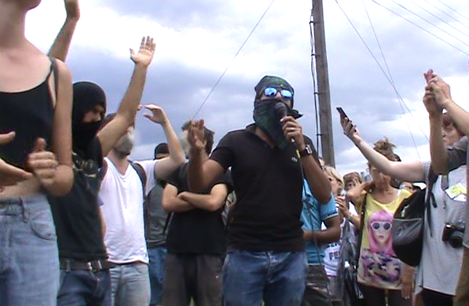 Figure 13 – A man singing during a protest outside a detention center in Paranesti, Greece, July 2016, photo by Ioannis Christidis.
Figure 13 – A man singing during a protest outside a detention center in Paranesti, Greece, July 2016, photo by Ioannis Christidis.
These protest-singers addressed the rest of the protesters-audience through the microphone and the speakers. In many cases the original lyrics of songs were modified to adjust to each special occasion, accompanied by rousing speeches. This role – of the singers of the protests – has been also documented throughout many protests in Syria (see: Halasa, Omareen, and Mahfoud 2014; Issa 2016). Coincidentally, one of these protest-singers of Syria was among those young men who performed their songs in the streets of Thessaloniki. Besides these types of songs and their special public performances, there were other contexts for singing. For instance, within evening-gatherings or parties of young men in tents, cafés or in private spaces. These performances, although most of them male-exclusive, were more participatory in their essence, involving intense emotional interactions and musical empathy between the main performers and their companions. A particular context for singing was within the music contest "Refugees got Talent," organized by the "Refugee TV" initiative in the refugee camp of "Oreokastro."
24 The song repertoires in this contest were again mainly related to the Syrian revolution and the refugee experience. The voting took place on Facebook and the finalist show was live-streamed. Within this event, singing gave the opportunity for staging and self-presentation, perhaps being, at the same time, a chance for the residents of the camp to forget their abject living conditions. Finally, in the refugee camp of "Softex" there was an exceptional documentation of a Muslim call for prayer 🎬 (Sample 11), known as adhan, where singing took the form of improvised chanting following specific modal rules.
Initial assumptions and emerging issues
A first general impression as regards the musical performances documented in Thessaloniki is that the memory of Syria and the Syrian revolution, the still fresh experiences of the risky and agonized refugee journey towards Europe, and the protest sentiments fired by the closure of the borders, constituted pivotal experiential sources for Syrian refugees' musical expressions. Even though most of them were actualized within protest events – that is outward acts that aim to attract public attention – they were seemingly inwardly directed, being suggestive more of a tactic for self-empowerment than one of self-representation. Considering the very special conditions, audiences and on-the-spot emerging factors, the exact purpose, function and meaning of these performances for their individual actors remain somewhat unclear. However, what is clear at this point is that before lightly proceeding to any claims about the role of music in the experience of forced migration of the people that managed to flee Syria, there are important historical and political factors about Syria and about flight towards Europe to be taken into consideration.
Freedom of speech and political expression – and sometimes of linguistic expressions of certain minorities, such as the Kurds – has been censored and prosecuted over the 50 years of the Assad family’s governance of Syria. Specifically, in 1982, Syrian government suppressed violently an uprising that took place in the city of Hama, leaving thousands of dead civilians and ruins behind. Since then, transgressions were only expressed indirectly and symbolically through the arts and satire (Wedeen 1999). In March 2011, the "Kingdom of Silence" – a description given to the regime by many Syrians (Yassin-Kassab and Al-Shami 2016) – was disrupted by the revolutionary anti-regime protest, which often took the form of massive public music and dance performances. Amateur or professional singers employed a variety of tactics and means to encourage participation in protests, identifiable in the chosen type of songs – often wedding popular songs, known as arada, in simple and inspiring Arabic (Issa 2016) – and in the further dissemination of recorded performances through the use of video and internet (Cooke 2017, Yassin-Kassab and Al-Shami 2016). Unfortunately, these protests faced deadly violence from Assad's regime – 2,500 deaths in the first six months, detentions and torture, a crucial reason for the further escalation of violence into a civil war and of course into mass flight out of Syria. By 2013 fanatic Islamic militias started to play a determinative role within the war conflict, contributing from their point of interest to the restriction of established freedoms in liberated areas and driving ever more people into exile (Yassin-Kassab and Al-Shami 2016).
In 2018, the counted population of dispersed Syrians was 5.62 million,
25 of which about one million (18%) have moved to Europe since the beginning of the war. More than 550,000 moved to Germany between 2011 and 2017, about 110,000 to Sweden and nearly 50,000 to Austria.
26 The majority of people fleeing from Syria and seeking asylum in Europe are ensnared by the structures and bureaucratic procedures of the international management of forced migration, as expressed within UNCHR, and its collaboration with the EU, and by on-the-spot national policies. However, refugee encampment, an extensively applied strategy, especially in reception countries such as Greece has proved, instead of a protection measure, to constitute for refugees an additional cause of trauma and humiliation.
27 Finally, Individuals who officially received the refugee status, still cannot claim full political rights in their host countries, being considered as temporary residents, but neither can they return to their homelands and their previous lives.
What comes up as an explanatory frame is that the musical expressions of the Syrian refugees in Thessaloniki in 2016 constituted a way for them to uphold the very new and strong feeling of freedom and dignity, experienced during the revolution back in Syria. A feeling that was dented, once again, because of the mistreatment and abandonment they experienced in 2016, by the European authorities and the United Nations. The participatory, indexical and emotional character of these performances, also documented in similar contexts throughout Europe (see: Emery 2017) and in Turkey (see: Kurtişoğlu, Öztürk and Hajj 2016) perhaps further denotes the emergence of a new trans-local Syrian political community unfettered from Syria's national and territorial bonds. An emergent community, on the one hand, of the "stateless" and dispersed refugees, but on the other, of "active citizens" whose collective consciousness – in the absence of institutional conventional frameworks for political participation – is partially shaped and performed within music and dance participatory experiences.
This hypothesis is currently examined through further communication and research collaboration with important actors of the musical performances of Thessaloniki, and through the conduct of further multi-sited field research, documentation and dialogic interpretation of the musical expressions of Syrian refugees and exiles in their current destinations in Europe. Additional to the above, another significant issue emerging for this research is the gender-biased character of the musical performances of Thessaloniki, its explanation and further challenging through the quest for female orientated performance contexts; for contexts modified to become gender-inclusive and for individual choices that suggest completely innovative solutions to the existing contexts.
29 Currently, field research is being conducted in Vienna, a city that constitutes a major destination for Syrian exiles and a blossoming scene for young, innovative and aspirational musicians of Syrian background. New findings will be published in the near future.
Notes
[1] This research article was written by Ioannis Christidis for the MMRC website in 2020. All copyrights have been clarified.
[2] During that period, the political initiative "Moving Europe" created a very well informed on-line map that shows the exact locations of the refugee camps in Northern Greece. You can find it here: http://moving-europe.org/mapping-of-refugee-camps-in-northern-greece/
[3] There are several cases where singers and composers of Greek popular music have appropriated Arabic songs and presented them as theirs. One such example is the song "Wala Qahed" composed by the Egyptian folk-singer Hakim (Abd El-Hakim Abd El-Samad Kamel) in 1998 for the album Hayel, which, in 2000, was recirculated by the Greek-Pontiac singer Lefteris Pantazis as “Ston Evdomo Ourano,” with, according to the album, music and Greek lyrics written by Dimos Milonas. Although there is no mention of the original composer, the released video-clip not only is full of images from Egypt but there can be identified in it an exact extract from the original song in Arabic.
[4] According to personal observation, very few people joined the circle or line dances of the young protesting refugees. I use the term "political" to describe music creations with content explicitly critical of the existing power hierarchies and society, usually associated with left-wing and anti-authoritarian ideas.
[5] Macarena is a world-wide famous hit of the 1990's recognizable by its characteristic melodic style and dance technique. Although originally composed with Spanish lyrics in 1993 by the group Los del Rio (Spain), it was its English version and remix by Bayside Boys produced in 1996 that hit the pop-music charts. It seems that this song was chosen by volunteers working in "Softex" refugee camp as part of children's creative activities. Beyond any doubt, it was a successful choice.
[6] Ethnomusicology is a discipline that studies music within its cultural, social and historical context. It was originally founded in the 1950s and is genealogically related to comparative ethnomusicology and folk music studies, as these appeared in Europe at the end of the 19th century and with US cultural anthropology and its ties with fieldwork methods at the beginning of the 20th century. It has been conceptualized differently in different countries and academic institutions. As of the late 1980s many ethnomusicologists have adopted post-colonial critical positions towards their own methods, setting into question existing power hierarchies within the relational context of their work as well as western-centered dominant epistemologies. For historical aspects and contemporary theoretical and methodological developments in ethnomusicology see: (Barz and Cooley 2008; Nettl 2010, 2015; Rice 2017)
[7] At the close of the previous century the term "applied ethnomusicology" was introduced among scholars in order to describe a diverse branch of activities that ethnomusicologists undertook beyond the traditional academic boundaries of knowledge production, for its own sake. Socially responsible research and music-centered interventions for the betterment of the social and financial conditions of the research participants, as well as for their cultural sustainability, today constitute key concepts within applied ethnomusicology. For historical, methodological and theoretical developments in applied ethnomusicology see: (Araújo 2008; Dirksen 2012; Harrison 2014, 2016; Pettan 2008, 2010; Pettan and Titon 2015; Sheehy 1992; Titon 1992).
[8] (Baily [2015] 2017, Baily and Collyer 2006; Caruso 2017; Côrte-Real 2010; Emery 2017; Gill 2019; Hemetek 2015a; Kölbl 2018; Kurtişoğlu, Öztürk and Hajj 2016; Öğüt 2016; Pettan 2015b; Rasmussen et al 2019; Reyes 1986, 1999a, 1999b, 2001, 2012; Ruana Posada 2016)
[9] (Hemetek 2001, 2010, 2015a, 2015b, 2016; Kovačič and Hofman 2019; O'Connell 2004; Pettan 2019)
[10] (Martiniello and Lafleur 2008, Ní Mhurchú 2016; Street 2012, Turino 2008)
[11] Specifically, I draw on post-structural (Barz and Cooley 2008) and feminist fieldwork approaches (Koskoff and Cusick 2014); multi-sited (Marcus 1995, Falzon 2009) and individual-centered ethnography (Rice 2003); and methods for field research on and for the internet (Hine 2015).
[12] For a general introduction to Arabic and Islamic music see: (Blum 2002; Danielson 1997; Racy 1983, 2003; Shiloah 1994, 1997; Touma 1996; Wright 1978; Wright, Poché, and Shiloah 2001). For research on the music of Syria see: (Bothwell 2018; Currey 2002; Jargy 1978; Shannon 2006, Silverstein 2016, 2018).
[13] Arabic and English rap music was very popular among young men, residents of the refugee camps of Thessaloniki. Moreover, given the opportunity of the presence of a microphone and some cheering beat playing to the background through the speakers, some of these young men would start improvisational rhyming. There were four such cases documented, unfortunately only in fieldnotes.
[14] For instance, the facebook pages of "Refugee.TV": https://www.facebook.com/pg/refugees.tv/videos/?ref=page_internal and "Help Refugees": https://www.facebook.com/groups/1096358837095826/videos/
[15] Most of the information around dabke is drawn on the scholarly work of Shayna Silverstein.
[16] This information is based on a testimony of Salah Ammo, a singer, composer and player of the buzuk of Kurdish-Syrian origin, who currently lives and works in Vienna (interviewed by the author on 13.07.2020)
[17] "Janna, Janna, Janna" is one of the songs I have recorded at least on four different occasions in Thessaloniki, in 2016, played through the speakers and danced by protesters. In the following link it is performed in Homs, Syria, in 2011 by the protest-singer Abdel-Baset Sarot and thousand more protesters: https://www.youtube.com/watch?v=F_cSbPPEGbo&t=5s
The following version of the song is recognized in two of my recordings (Abdel-Baset Sarot is referred as the singer, but we can listen to many different voices/persons singing): https://www.youtube.com/watch?v=wTn0W7FojcQ
In the following link, a Syrian blogger provides an English translation of the song: https://aminnoorblog.wordpress.com/2017/12/19/syrian-revolutionary-songs-translated-chant-2/
The same song with completely different lyrics can be found on YouTube as an old Jordanian patriotic song (2010): https://www.youtube.com/watch?v=wpd1VZyh5eE, and also performed by the Saudi-Iraqi singer Majid al-Muhandis: https://www.youtube.com/watch?v=5DyqPpbb4zk
[18] Original song on YouTube: https://www.youtube.com/watch?v=knJESy-paXU&list=RDknJESy-paXU&start_radio=1
The writer Gautama Mehta in his article "Every Arab refugee in the world knows this song" provides us a translation of the song's lyrics.
[19] This information was found in the reportage "The Arabic revolution song that went viral" written by Alma Hassoun for BBC: https://www.bbc.com/news/av/magazine-37121414/the-arabic-revolution-song-that-went-viral
[20] According to a testimony from one of the young men that used to sing this song in Thessaloniki, the message of this is about hope: "it is not for freedom, (it is) for everything good, that will be [...] this song is for my people!" When he sings this song, he remembers – and "feels" what he saw in Syria, and always cries. As he said: "WE saw a lot, we saw! And I know! But I lived.... I lived!" (interview: 25.10.2016)
[21] Initial version of "Sawfa Nabqa Huna" (2011): https://www.youtube.com/watch?v=nXOrvwjr4e0
Later interpretation with lyrics (2015): https://www.youtube.com/watch?v=rDnFKmK0jZU
It is still unclear whether the singer/composer of this song, Adel el Mshiti, was influenced by an Islamic chant or it happened the other way round.
[22] The information is based on an interview with one of the singers I met in Thessaloniki, that took place on-line on 23.07.2020.
[23] Bailando is a song that became a hit in 2014 by Enrique Inglesias ft. Descemer Bueno and Gente de Zona (album: Sex and Love).
[24] There is a very comprehensive documentary about this contest, directed by Theopi Skarlatos for Al-Jazeera, which provides information about the situation in refugee camps in Thessaloniki, Greece and the role of music and mobile technologies in the daily routine and resistance, specifically, in "Oreokastro" camp. You can watch it here: https://www.aljazeera.com/programmes/witness/2017/03/refugees-talent-170323115635234.html
[25] The population of Syria before the eruption of the revolution in 2011 was estimated at about 21.1 million: 80-85% Arabs; 10% Kurds; 4-5%Turkmen; 3-4% Assyrians; 1% Armenians. Source: World Population Prospects – Population Division – United Nations: https://population.un.org/wpp/
[26] Source: Pew Research Center: http://www.pewresearch.org/fact-tank/2018/01/29/where-displaced-syrians-have-resettled/ [15.01.2020].
[27] The following links lead to two statements about the situation in Greek refugee camps, coming from two officially regonized organizations, the "Greek Council for Refugees" and "Amnesty international."
[28] There is evidence from across Europe that corresponds with this hypothesis. One example is in Athens, the capital of Greece, where in 2018 a new transcultural initiative was founded, entitled "Syrian and Greek Youth Forum." Among other projects, the Forum runs the "Active Citizens Sound Archive." They say that: "We are recording our activisms and political inclusion activities. […]This work comes from recognizing the need to record this moment in Athens – to tell the world that we are building a collective movement aiming to advance the development of Syrians and other communities into active citizens in Athens and Greece. SGYF is a platform for citizenship." Looking into their uploaded recordings, one can directly realize that what they describe as "activism and political inclusion activities" is largely about participatory music-making. For more: https://citizensoundarchive.com/
Another example can be found in Vienna, Austria. One of the main activities of the Austrian-Arab Women Association is the "NAI Oriental Orchestra." Consisting of 2/3 Syrian and 1/3 different nationalities, besides its trans-cultural character that aims to bridge middle-Eastern culture with Austrian society, this project, according to Marie Therese Kiriaky, the coordinator of the Association of Syrian origins, is also a way "to reunify the scattered components of our [Syrian] society. Because in Syria we had 19 religions and ethnicities. These people are now split up and down, horizontally and vertically. [...]In our work there is no discussion about politics, or religion. Here, we are Syrians. And we should try to be really responsible and to understand that we should introduce ourselves in a civilized way." (extract from interview conducted by Ioannis Christidis, 15.06.2020). Although not ideological, I deem this approach very political in the sense that an orchestra offers the context for experiencing what Syria could be: a multi-national, mutli-religious, democratic society. For more: https://arabaustrianwomen.org/?page_id=117
[29] My research until now has focused on the most explicit and public aspects of music within the context of Thessaloniki, which for reasons that will be illustrated in a next article are mainly pertaining to masculine expressions. This does not mean that there were not less public or non-masculine contexts for musical performances. One such example, already mentioned, was the "Macarena" performance, which most times constituted an invitation for children to dance, motivated by young men, residents of the camps, who from passionate protesters were transforming into children entertainers. Another example, documented only in testimonies, was the belly-dance and drag show nights in a local queer space in Thessaloniki, where LGBTIQ forced migrants found shelter, escaping both war and refugee camps. These performances were "safeguarded" because they were primarily serving as safe-spaces. However, this does not render them less "political" than the performances in public arenas. The political aspect of these performances can be understood through a critical feminist approach on what is political, by perceiving the diverse sexuality and gender expressions as expressions of power – subjected to political struggle – and by disputing the traditional dichotomy between public and private spheres and, thus, the separation between politics and personal life.
References
Araújo, Samuel. (2008). "From Neutrality to Praxis: The Shifting Politics of Ethnomusicology in the Contemporary World." In: Musicological Annual 44(1): 13-30. https://revije.ff.uni-lj.si/MuzikoloskiZbornik/article/view/3105/2823 [27.07.2020].
Baily, John and Dr Michael Collyer. (2006). "Introduction: Music and Migration." In: Journal of Ethnic and Migration Studies 32(2): 167-182.
Baily, John. ([2015] 2017). War, Exile and the Music of Afghanistan: The Ethnographer’s Tale. London: Routledge, Taylor and Francis Group.
Barz, Gregory F. and Timothy J. Cooley. (2008). Shadows in the Field. USA, New York: Oxford University Press.
Blum, Stephen. (2002). "Hearing the Music of the Middle East." In: The Garland Encyclopedia of World Music. Volume 6: The Middle East, edited by Virginia Danielson, Scott Marcus and Dwight Reynolds. New York, London: Routledge: 3-13.
Bothwell, Beau. (2018). "State, Song, and Shabāb in Syria’s Prewar Radioscape." In: Asian Music 49(1): 80-119.
Caruso, Fulvia. (2017). "Music and migration. Una ricerca/azione nel centro della pianura Padana." In: Scuola, migrazioni e pluralismo religioso, edited by Fulvia Caruso and Vinicio Ongini. Todi: Tau: 151–160.
Cooke, Miriam. (2017). Dancing in Damascus. US, New York: Routledge.
Côrte-Real, Maria de São José. (2010). "Introduction: Citizenship, Music and Migration." In: Music and Migration, Migrações 7: 11-24.
Currey, Nancy E. (2002). "History in Contemporary Practice: Syria's Music Canon." In: Middle East Studies Association Bulletin 36(1):9-19.
Danielson, Virginia. (1997). The Voice of Egypt: Umm Kulthum, Arabic Song, and Egyptian Society in the Twentieth Century. US: University of Chicago Press.
Dirksen, Rebecca. (2012). "Reconsidering Theory and Practice in Ethnomusicology: Applying, Advocating, and Engaging Beyond Academia." In: Ethnomusicology Review 17. https://ethnomusicologyreview.ucla.edu/journal/volume/17/piece/602 [27.07.2020].
Emery, Ed. (2017). "Radical Ethnomusicology: Towards a Politics of 'No Borders' and 'Insurgent Musical Citizenship' – Calais, Dunkerque and Kurdistan." In: Ethnomusicology Ireland 5: 48-74. https://www.ictm.ie/radical-ethnomusicology-towards-a-politics-of-no-borders-and-insurgent-musical-citizenship-calais-dunkerque-and-kurdistan-ed-emery/ [15.01.2020].
Falzon, Mark-Anthony, ed. (2009). Multi-sited Ethnography: Theory, Praxis and Locality in Contemporary Research. UK: Ashgate publishing.
Gill, Denise. (2019). "Refugee Death and Lament as Epistemological Framework." In: Ethnomusicology 63(2): 299-304.
Halasa, Malu, Zaher Omareen, and Nawara Mahfoud, eds. (2014). Syria Speaks: Art and Culture from the Frontline. UK, London: Saqi Books.
Harrison, Klisala (2014). "The Second Wave of Applied Ethnomusicology." In: Musicultures. 41(2):15-33. https://www.academia.edu/12643132/The_Second_Wave_of_Applied_Ethnomusicology [27.07.2020].
Harrison, Klisala (2016). "Why Applied Ethnomusicology?" In: COLLeGIUM: Studies across disciplines in the the humanities and social sciences. Finland: Helsinki Collegium for Advanced Studies. https://helda.helsinki.fi/bitstream/handle/10138/167843/Collegium%20Vol%2021%20Introduction.pdf?sequence=1 [27.07.2020].
Hemetek, Ursula. (2001). "Music and Minorities: Some Remarks on Key Issues and Presuppositions of the Study Group." In: Glasba in manjsine / Music and Minorities, edited by Pettan, Svanibor, Adelaida Reyes, and Maša Komavec. Ljubljana: ZRC Publishing and Institute of Ethnomusicology SRC SASA: 21-29.
Hemetek, Ursula. (2010). "Unexpected Musical Worlds of Vienna: Immigration and Music." In: Migrações Journal – Special Issue Music and Migration 7, edited by Maria de São José Côrte-Real: 115-138.
Hemetek, Ursula. (2015a). "Applied Ethnomusicology as an Intercultural Tool: Some Experiences from the Last 25 Years of Minority Research in Austria." In: The Oxford Handbook of Applied Ethnomusicology, edited by Svanibor Pettan and Jeff Todd Titon. New York: Oxford University Press: 229-277.
Hemetek, Ursula. (2015b). "Music of Minorities – 'The Others from Within?' On Terminology and the History of Research in Austria." In: Musicologica Austriaca - Journal for Austrian Music Studies (peer reviewed), edited by Wolfgang Fuhrmann and Dominik Sedivy. Austrian Musicological Society. http://www.musau.org/parts/neue-article-page/view/18 [27.07.2020].
Hemetek, Ursula. (2016). "History, Theory and Methods of Minority Research in Ethnomusicology: The Past, the Present and Visions for the Future." In: World Music Studies, edited by Regine Allgayer-Kaufmann. Berlin: Logos Verlag, 93-112.
Hine, Christine. (2015). Ethnography for the Internet: Embedded, Embodied and Everyday. London: Bloomsbury.
Issa, Sadam. (2016). "Ibrahim Qashoush’s Revolutionary Popular Songs: Resistance Music in the 2011 Syrian Revolution." In: Popular Music and Society 41(3): 283-301.
Jargy, Simon. (1978). "The Folk Music of Syria and Lebanon." In: The World of Music 20(1). Verlag für Wissenschaft und Bildung: 79-93.
Kölbl, Marko. (2018). Projektbericht: Musikalische Identifikationen von Jugendlichen Geflüchteten (vorwiegend Afghanistan). Austria, Vienna: Institut für Volksmusikforschung und Ethnomusikologie.
Koskoff, Ellen and Suzanne Cusick. (2014). A Feminist Ethnomusicology: Writings on Music and Gender. USA: University of Illinois Press.
Kovačič, Mojca and Ana Hofman. (2019). "Music, Migration and Minorities: Perspectives and Reflections." In: Musicological Annual 55(2): 5-17.
Kurtişoğlu, Belma, Selda Öztürk and Hussain Hajj. (2016). "Performing Migration." In: Mahanirban Calcutta Research Group (eds.). Refugee Watch: A South Asian Journal on Forced Migration 48.
Marcus, George E. (1995). "Ethnography in/of the World System: The Emergence of Multi-sited Ethnography." In: Annual Review of Anthropology 24: 95-117.
Martiniello, Marco and Jean-Michel Lafleur. (2008). "Ethnic Minorities’ Cultural and Artistic Practices as Forms of Political Expression: A Review of the Literature and a Theoretical Discussion on Music." In: Journal of Ethnic and Migration Studies 34(8): 1191-1215.
Nettl, Bruno. (2005). The Study of Ethnomusicology: Thirty-one Issues and Concepts. US, Urbana: University of Illinois Press.
Nettl, Bruno. (2010). Nettl’s Elephant. On the History of Ethnomusicology. US, Urbana: University of Illinois Press.
Ní Mhurchú, Aoileann. (2016). "Unfamiliar Acts of Citizenship: Enacting Citizenship in Vernacular Music and Language from the Space of Marginalized Intergenerational Migration." Citizenship Studies 20(2): 156-172.
O'Connell, John Morgan. (2004). "Sustaining Difference: Theorizing Minority Music in Badakhshan." In: Manifold Identities. Studies of Music and Minorities, edited by Ursula Hemetek, Gerda Lechleitner, Inna Naroditskaya, and Anna Czekanowska. UK, London: Cambridge Scholars Press: 1-19.
Öğüt, Evrim Hikmet. (2015). PhD Thesis: Music in Transit: Musical Practices of the Chaldean-Iraqi migrants in Istanbul. Istanbul, Turkey: Istanbul Technical University – Institute of Social Sciences – Department of Music Programme.
Pettan, Svanibor. (2008). "Applied Ethnomusicology and Empowerment Strategies: Views from across the Atlantic." In: Musicological Annual 44(1): 85-99. https://revije.ff.uni-lj.si/MuzikoloskiZbornik/article/view/3109/2826 [27.07.2020].
Pettan, Svanibor. (2010). "Applied Ethnomusicology: Bridging Research and Action." In: Music and arts in action 2(2): 90–93. http://www.musicandartsinaction.net/index.php/maia/article/view/ethnomusicology/44 [27.07.2020].
Pettan, Svanibor and Jeff Todd Titon, eds. (2015a). The Oxford Handbook of Applied Ethnomusicology. USA, New York: Oxford University Press.
Pettan, Svanibor. (2015b). Kosovo through the Eyes of the Local Romani (Gypsy) Musicians. DVD with Study Guide. University of Ljubljana, Faculty of Arts and Society for Ethnomusicology.
Pettan, Svanibor. (2019). "Sounds of Minorities in National Contexts." In: Musicological Annual 55(2): 41-64.
Posada, Violeta Ruano. (2016). "Portraits of Saharawi Music: When Cultural Preservation meets Political Activism." In: African Music: Journal of the International Library of African Music 10(2): 109-25.
Racy, Ali Jihad. (1983). "The Waslah: A Compound-Form Principle in Egyptian Music." In: Arab Studies Quarterly 5(4): 396-403.
Racy, Ali Jihad. (2003). Making Music in the Arab World: The Culture and Artistry of Tarab. Cambridge: Cambridge University Press.
Rasmussen, Anne K., Angela Impley, Rachel Beckles Willson, Ozan Aksoy, Denise Gill, and Michael Frishkopf. (2019)."Ethnomusicological Responses to the Contemporary Dynamics of Migrants and Refugees." Ethnomusicology 63(2): 279-314.
Reyes, Adelaida. (1986). "Tradition in the Guise of Innovation: Music among a Refugee Population." In: Yearbook for Traditional Music 18: 91-102.
Reyes, Adelaida. (1999a). Songs of the Caged, Songs of the Free. Music and the Vietnamese Refugee Experience. Philadelphia: Temple University Press.
Reyes, Adelaida. (1999b). "From Urban Area to Refugee Camp: How One Thing Leads to Another." In: Ethnomusicology. 43(2): 201-220.
Reyes, Adelaida. (2001). "Music, Migration and Minorities: Reciprocal Relations." In: Glasba in manjsine / Music and Minorities, edited by Pettan, Svanibor, Adelaida Reyes and Maša Komavec. Ljubljana: ZRC Publishing and Institute of Ethnomusicology SRC SASA: 37-45.
Reyes, Adelaida. (2012). "Urban Ethnomusicology: A Brief History of an Idea." In: Urban People/ Lidé Města. Theory and Method in Urban Ethnomusicology 14(2): 193-206.
Rice, Timothy. (2003). "Time, Place, and Metaphor in Musical Experience and Ethnography.2 In: Ethnomusicology 47(2): 151– 179.
Rice, Timothy. (2017). Modeling Ethnomusicology. UK: Oxford University Press.
Rowe, Nicholas.(2010). Raising Dust: A Cultural History of Dance in Palestine. London and New York: I.B.Tauris & Co.
Shannon, Jonathan H. (2006). Among the Jasmine Trees: Music and Modernity in Contemporary Syria. Wesleyan University Press.
Shiloah, Amnon. (1994). Music in the World of Islam: A Socio-Cultural Study. UK: Scolar Press.
Shiloah, Amnon. (1997). "Music and Religion in Islam." In: Acta musicologica 69(2): 143-155.
Sheehy, Daniel. (1992). "A few Notions about Philosophy and Strategy in Applied Ethnomusicology." In: Ethnomusicology. Special Issue: Music and the Public Interest. 36(3): 323-336.
Silverstein, Shayna. (2012). "Syria's Radical Dabka." In: Middle East Report 42(263): 33-37.
Silverstein, Shayna. (2016). "The Punk Arab: Demystifying Omar Souleyman's Techno-Dabke." In: Punk Ethnography: Artists and Scholars Listen to Sublime Frequencies, edited by Michael Veal and E. Tammy Kim. Wesleyan. CT: Wesleyan University Press: 265-287.
Silverstein, Shayna. (2018 [2020]). "The Stars of Musiqa Sha’biyya." Online-network Norient: https://norient.com/academic/new-wave-dabke/ [27.07.2020].
Street, John. (2012). Music & Politics. UK, Cambridge: Polity Press.
Titon, Jeff Todd. (1992). "Music, the Public Interest, and the Practice of Ethnomusicology." In: Ethnomusicology. Special Issue: Music and the Public Interest. 36(3): 315-322.
Touma, Habib Hassan. (1996). The Music of the Arabs. Portland: Amadeus Press.
Turino, Thomas. (2008). Music as Social Life: The Politics of Participation. Chicago: The University of Chicago Press.
Wedeen, Lisa. (1999). Ambiguities of Domination: Politics, Rhetoric, and Symbols in Contemporary Syria. USA, Chicago: University of Chicago Press.
Wright, Owen. (1978). The Modal System of Arab and Persian Music A.D. 1250-1300. Oxford University Press.
Wright, Owen, Christian Poché, and Amnon Shiloah. (2001). "Arab Music." In: Groove Music Online Encyclopedia. http://www.oxfordmusiconline.com/subscriber/article/grove/music/01139 [15.01.2020].
Yassin-Kassab, Robin and Leila Al-Shami. (2016). Burning Country. London: Pluto Press.
List of Figures
Figure 1 – Tents inside the warehouse of the abandoned factory of "Softex," Thessaloniki, 2016, photo by Ioannis Christidis.
Figure 2 – A young man writing slogans on the wall of the camp. Picture from "Softex" refugee camp, Thessaloniki, 2016, photo by Ioannis Christidis.
Figure 3 – Tents inside "Oreocastro" old warehouse converted into refugee camp. Slightly can be seen the word "tomb" written on the tent. Residents of the camp compared the camp with a cemetery. Thessaloniki, 2016,
photo by Ioannis Christidis.
Figure 4 – Words and slogans written on a wall in "Oreokastro" refugee camp, Thessaloniki, 2016, photo by Ioannis Christidis.
Figure 5 – Children playing in "Vassilika" refugee camp, Thessaloniki, 2016, photo by Ioannis Christidis.
Figure 6 – Living conditions in "Vassilika" refugee camp, Thessaloniki, 2016, photo by Ioannis Christidis.
Figure 7 – Living conditions in "Diavata" refugee camp I, Thessaloniki, 2016, photo by Ioannis Christidis.
Figure 8 – Living conditions in "Diavata" refugee camp II, Thessaloniki, 2016, photo by Ioannis Christidis.
Figure 9 – A man performing the saz during a protest at the campus of Aristotle University of Thessaloniki, July 2016, photo by Ioannis Christidis.
Figure 10 – A man performing the oud in "Oreokastro" refugee camp, screenshot from Al-Jazeera's documentary "Refugees got Talent," by Theopi Skarlatos, March 2017. On-line: https://www.aljazeera.com/programmes/witness/2017/03/refugees-talent-170323115635234.html [03.08.2020].
Figure 11 – A man performing the guitar in "Oreokastro" refugee camp, screenshot from Al-Jazeera's documentary "Refugees got Talent," by Theopi Skarlatos, March 2017. On-line: https://www.aljazeera.com/programmes/witness/2017/03/refugees-talent-170323115635234.html [03.08.2020].
Figure 12 – A man performing the darbuka in "Oreokastro" refugee camp, screenshot from Al-Jazeera's documentary "Refugees got Talent," by Theopi Skarlatos, March 2017. On-line: https://www.aljazeera.com/programmes/witness/2017/03/refugees-talent-170323115635234.html [03.08.2020].
Figure 13 – A man singing during a protest outside a detention center in Paranesti, Greece, July 2016, photo by Ioannis Christidis.
List of Samples
Sample 1 – Audio – Slogan "Hurriye, Azadi, Freedom Now!" – Thessaloniki – 01.09.2016, recorded by Ioannis Christidis
Sample 2 – Audio – People singing and dancing "Janna, Janna, Janna" during a protest – Thessaloniki – 01.09.2016, recorded by Ioannis Christidis.
Sample 3 – Video – Dabke dance performance – "Softex" Camp – Thessaloniki – 17.07.2016, recorded by Ioannis Christidis.
Sample 4 – Video – Macarena dance performance – "Softex" Camp – Thessaloniki – 17.07.2016, recorded by Ioannis Christidis.
Sample 5 – Video – Men singing in a bus – 21.07.2016, recorded by Ioannis Christidis.
Sample 6 - Video – Children shouting slogans with makeshift percussion – Thessaloniki – 01.09.2016, recorded by Ioannis Christidis.
Sample 7 – Video – Dabke dance performance during NoBorder protest – 21.07.2016, recorded by Ioannis Christidis.
Sample 8 – Audio – Young men singing "Janna, Janna, Janna" during a protest – Thessaloniki – 21.10.2016, recorded by Ioannis Christidis.
Sample 9 – Audio – A young man singing "Safarna ala Euroba" – Thessaloniki-Paranesti – 20.07.2016, recorded by Ioannis Christidis.
Sample 10 – Audio – Young men singing "Sawfa Nabqa Huna" – Thessaloniki – 28.06.2016, recorded by Ioannis Christidis.
Sample 11 – Video – Adhan: Muslim call for prayer – "Softex" Camp Thessaloniki – 09.08.2016, recorded by Ioannis Christidis.
